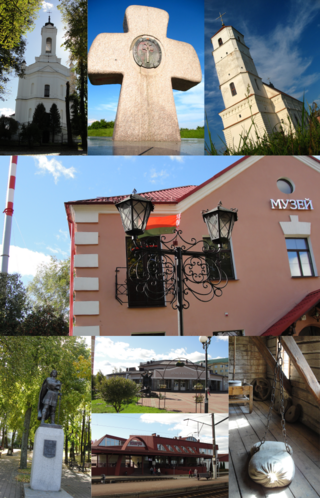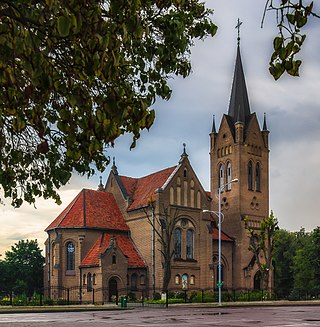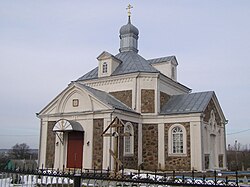
Minsk Region, also known as Minsk Oblast or Minsk Voblasts, is one of the six regions of Belarus. Its administrative center is Minsk, although it is a separate administrative territorial entity of Belarus. The region's population was recorded at 1,411,500 in 2011.

Slutsk is a town in Minsk Region, Belarus. It serves as the administrative center of Slutsk District, and is located on the Sluch River 105 km (65 mi) south of the capital Minsk. As of 2024, it has a population of 60,056.

Valozhyn or Volozhin is a town in Minsk Region, Belarus. It serves as the administrative center of Valozhyn District. It is located 75 km (47 mi) northwest of the capital Minsk, on the Valozhynka River in the Neman River basin, and the beginning of the Naliboki forest. In 1995, its population was approximately 11,500. As of 2024, it has a population of 10,015.

Nyasvizh or Nesvizh is a town in Minsk Region, Belarus. It serves as the administrative centre of Nyasvizh District. Nyasvizh is the site of Nesvizh Castle, a World Heritage Site. In 2009, its population was 14,300. As of 2024, it has a population of 15,968.

Zaslawye or Zaslavl is a town in Minsk District, Minsk Region, Belarus. It is located 20 kilometres (12 mi) northwest of the capital Minsk. In 2009, its population was 14,400. As of 2024, it has a population of 17,404.

Vileyka or Vilyeyka is a town in Minsk Region, Belarus. It serves as the administrative center of Vileyka District. It is located on the Viliya River, 100 kilometres (62 mi) northwest of Minsk. The first historical record dates from 16 November 1460. As of 2024, the town has a population of 26,625.

Klyetsk or Kletsk is a town in Minsk Region, Belarus. It serves as the administrative center of Klyetsk District. Klyetsk is located on the Lan River. As of 2024, it has a population of 11,248.

Pyetrykaw or Petrikov is a town in Gomel Region, Belarus. It serves as the administrative center of Pyetrykaw District. At the 2009 census, its population was 10,591. As of 2024, it has a population of 10,401.

Krupki is a town in Minsk Region, Belarus. It serves as the administrative center of Krupki District.

Dzyatlava or Dyatlovo is a town in Grodno Region, Belarus. It serves as the administrative center of Dzyatlava District. It is located about 165 kilometres (103 mi) southeast of Grodno. The population was 7,700 in 2016. As of 2024, it has a population of 7,767.

Chervyen District or Červień District is a district (raion) of Minsk Region in Belarus. Its administrative center is Chervyen. As of 2024, it has a population of 33,401.

Kapyl District or Kapyĺ District is a district (raion) of Minsk Region in Belarus. Its administrative center is Kapyl. As of 2024, it has a population of 26,533.

Klyetsk District or Klieck District is a district (raion) of Minsk Region in Belarus. Its administrative center is the town of Klyetsk. As of 2024, it has a population of 25,611.

Krupki District is a district (raion) of Minsk Region in Belarus. Its administrative center is the town of Krupki. Also located in the district are the urban-type settlements of Bobr and Khalopyenichy. As of 2024, it has a population of 21,723.

Lahoysk District or Lahojsk District is a district (raion) of Minsk Region in Belarus. Its administrative center is the city of Lahoysk. As of 2024, it has a population of 38,519.

Myadzyel District or Miadziel District is a district (raion) of Minsk Region in Belarus. Its administrative center is the town of Myadzyel. As of 2024, it has a population of 24,326.

Smalyavichy District or Smaliavičy District is a district (raion) of Minsk Region in Belarus. Its administrative center is the town of Smalyavichy. The town of Zhodzina is administratively separated from the district. As of 2024, it has a population of 55,439.

Lyuban is a town in Minsk Region, Belarus. It serves as the administrative center of Lyuban District. In 2009, its population was 11,256. As of 2024, it has a population of 11,339.

Surazh is an urban-type settlement in Vitebsk District, Vitebsk Region, Belarus. It is located approximately 45 kilometres (28 mi) northeast from the city of Vitebsk. It is situated at the crossing of the Daugava and Kasplya rivers. As of 2024, it has a population of 672.






















